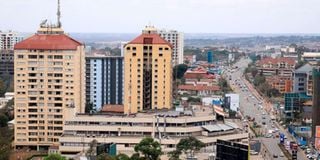How Kilimani, Kileleshwa are fast turning into Nairobi's new 'slums'

A view of Kileleshwa estate.
Uncontrolled development of high-rise apartments in Kilimani, Kileleshwa and Lavington areas is now putting a strain on available amenities and may soon turn the areas into vertical slums if left unchecked.
Property owners and residents of the area say the trend has been brought about by new developers who are acting in total disregard to existing zoning by-laws, plot ratios, ground coverage, environmental issues and without observation of the capacity of the available infrastructure services.
They are worried that if the governor of Nairobi does not tighten ropes on the supervision of upcoming buildings, the estates will easily turn into high density areas like Kayole, Pipeline and Embakasi and other densely populated areas.
“As property and residents of this area, we have seen that unless we raise our voices on this issue, in the long term, this is going to have some very serious repercussions. Trends are changing, we do not have to be rigid with our bylaws but what is coming up must go parallel with the existing infrastructure network,” said Ol Kalou MP David Kiaraho, an architect and investor in Kilimani.
He explained that in the Kilimani area, investors knew from the onset that the ground coverage was 35 percent with a plot ratio of 75 percent and for that zoning policy to be established, a number of factors had been considered including the available infrastructure network that is the sewer, road network and water amongst others.
However, he pointed out that in one development along Kindaruma road for example, a new developer has established 900 units bedsitters, studio and one-bedroom apartments within an about acre of space.
“This means that in terms of density, the sewer, which was designed over 50 years ago, and the pipes erected then cannot support the upcoming population. The situation also puts a strain on the existing road network for example this Kindaruma road is destined for expansion and anyone coming up with development in this area is supposed to surrender some six metre building line but that is not being observed.” he explained.
In December 2021, the Nairobi Metropolitan Services (NMS) withdrew an approval that had been granted to the developer and stopped the firm from making further constructions to avoid legal action after the local residents’ association complained.
In its letter to the developer reference number EOP/NMS/DC/L/0074/PAA/rmm NMS Director of Planning and urban development said its officers visited the site on December 10 and established that the building plans were not properly drawn, failed to provide sufficient information and its lounges are not properly ventilated.
“870 units on a 0.463ha are not acceptable since they exceed the ratios provided. Setback on basement is not observed and no traffic management report was provided,” the letter stated.
The residents said the developer has since disregarded the warning and construction is ongoing.
The MP said he will table the issue on the floor of parliament to ensure that laws are tightened against uncontrolled development.
“We gave some greedy developers who are finding their way to this area coming up with structures that we have never seen. I am challenging the Architectural Association of Kenya (AAK) and more so the governor of Nairobi to stamp their authority and mitigate what has gone wrong, if we do not do this now, in 50 years or so, this will be a proper slum,” he added.
Residents feel the approvals are granted illegally to rogue developers by rogue professionals.
“Cities are planned all over the world, there is no way we can continue with this trend and think that we are going to have Nairobi years to come. I am going to raise this issue in parliament so that we safeguard the industry, as an architect some of these things are totally unexpectable,” he said.
George Nyagah, a resident of Kilimani said they have started feeling the effects of the problem with a serious shortage in water supply and bursting of sewer pipes.
“For the last one year, we have been buying water in bowsers consistently whose quality is not good. Where I live, we have a development coming up with over 400 houses and the question we are asking is; if right now we have about 100 houses on our streets, where are we going to get additional water to service the extra houses at once?”
He added that the sewer’s piping system has currently burst and is pouring the waste into Kirichwa river.
“We are hoping that we can be heard that some of these agencies can come together and sort out this mess. It's not just Kilimani and Kileleshwa, even Lavington is having the same problem if you go to Chalbi road. We hope that something good can come from this,” said Mr Nyaga.
Though some of the new developers are able to sink their own boreholes, the residents said they still tap from the existing water systems and further inconvenience earlier settlers who may not be able to sink boreholes for their single units.





